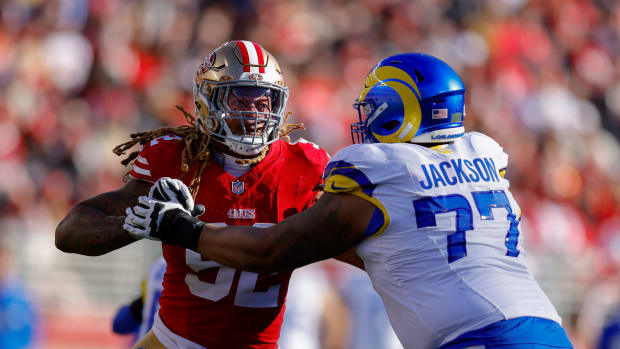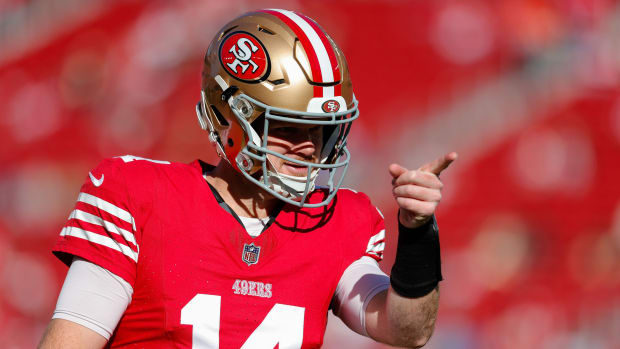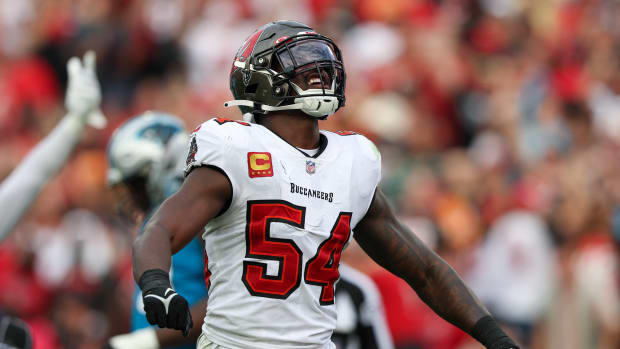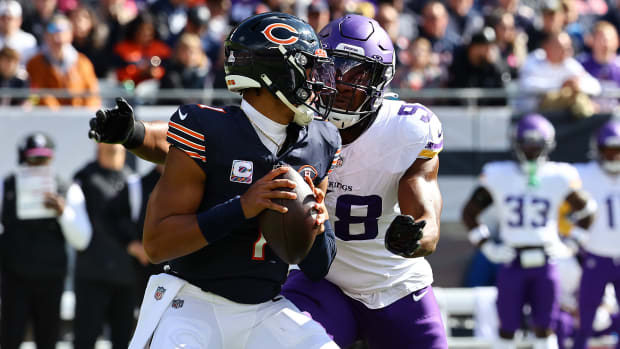NFL finally tapping into power of data
By Joe Lindsey, WIRED
The NFL may be the most popular and profitable major sport in America, but until recently, it’s lagged behind other leagues in sophisticated use of data analysis.
“We’ve done work across all major sports,” says Ray Hensberger, director of Sports Analytics at consulting group Booz Allen Hamilton. “The NFL has historically had the least amount of data.” At least some of that deficit was due to the challenge of how to get good data, which starts with how to record what actually happens on the field.
In baseball, certain situations like hitter vs. pitcher break down into discrete player vs. player scenarios which can be tracked relatively easily by human eyes, with perhaps a camera to help identify where the ball is in the strike zone. In basketball, the relatively small floor and low number of players are amenable to optical tracking systems like STATS LLC’s SportVU, which is also used in soccer.
But American football is a special challenge: the field is 53.3 yards wide and 120 yards long. That’s similar to soccer, as is the number of players on the field. What’s different: The profusion of offensive and defensive sets, plus constant player substitution. There’s so much activity and so many variables in game play, says Darryl Lewis, Chief Technology Officer at STATS LLC, that it’s almost impossible for humans to keep up without computer tracking technology.
Look for new entries in the Super Bowl 100 series, presented by Gatorade and Microsoft Surface, at SI.com/SB100 and Wired.com/SB100
Chapter 1, Oct. 7 TRAINING
Chapter 2, Oct. 28 EQUIPMENT
Chapter 3, Nov. 18 STADIUMS
Chapter 4, Dec. 9 CONCUSSIONS
Chapter 5, Dec. 16 MEDIA
Chapter 6, Dec. 30 VR
Chapter 7, Jan. 6 NFL IN SOCIETY
Chapter 8, Jan. 13 TRACKING
Chapter 9, Jan. 20 STRATEGY
Chapter 10, Jan. 27 SB 100
ROAD MAP TO
THE FUTURE
And that’s not even taking into account what Vishal Shah, the NFL’s Vice President of Digital Media and Business Development, calls “occlusion issues,” which is an elegant way of saying how to figure out what’s happening as 300-pound bodies collide in that closely-fought scrum along the line of scrimmage. Without reliable player tracking, big data lagged behind and, with it, more meaningful understanding of the game itself.
But after several years of quietly testing different player tracking systems, the NFL selected an RFID system from Zebra Technologies and rolled it out at 18 stadiums last season. The pilot went so well, says Shah, that they've expanded to all 32 teams this year. “The ultimate goal is to track the X/Y/Z coordinates of every player on the field, and the ball, down to a resolution of inches,” he says. And with Zebra, they’re pretty much there.
You can already see the results, particularly if you’re using a Microsoft Xbox One to access the NFL’s Next Gen Stats features. But while fan engagement and a better broadcast experience are firmly part of the NFL’s plans for its new toy, it’s equally obvious that the terabytes of data that computer tracking will produce will change the game itself. But there’s a lot of work to do to realize that goal.
Zebra’s sport tracking system is adapted from RFID technology it uses in other industries. RFID is key, says Jill Stelfox, Vice President and General Manager at Zebra, because “one of the key things about it is the location piece is so accurate.” GPS technology for civilian use has a maximum horizontal location accuracy of three meters—too rough to know where exactly a player is on the field, particularly if the goal is to assess proximity to another player like a cornerback in man-to-man coverage. (Some GPS systems can use additional technologies to refine accuracy further.)
Each player has two nickel-sized sensors, one under each shoulder pad, that communicate via a unique radio frequency to receivers mounted around both the upper and lower decks of the stadium. The system tracks player speed and distance traveled, as well as acceleration and deceleration. With two sensors, the system can also track player orientation, or which way he’s facing.
Just getting the data was the first step. Shah said that one of the main goals of the 2014 pilot was to work out any kinks. “Stadium environments are very rough,” he says, noting that one of the obstacles includes dealing with the radio frequency interference generated by 80,000 fans with cell phones. But even now that the NFL knows it can track every player 15 times a second, there’s a far bigger challenge: what to do with all that data. For the league and its teams to realize their data dreams, here’s what needs to happen:
Data Alone Isn’t Enough
“If I had to use one word to describe analytics right now, I’d say ‘noise’,” says Dr. Phil Wagner. A physician and former elite athlete, Wagner founded Sparta Sports Science, a San Francisco Bay Area training facility with a strong data science streak. When athletes test their vertical jump on a sophisticated force plate system, Sparta’s proprietary software, SpartaTrac, can measure any number of variables that Wagner calls an athlete’s movement signature. That signature can identify strengths and weaknesses, or even warn of impending injury. But he distills that down to three main metrics, called Load/Explode/Drive. That was by design. “We limited the data because we wanted only the most reliable data points,” says Wagner. “Inconsistency erodes trust and raises doubts about your expertise. We’re trying to reduce the amount of information people need to make decisions off of.” But that simple end product hides a decision tree that Wagner says has thousands of variables.
That’s where the NFL is now. “It’s great that you can track every player on the field, but so what?” says Hensberger. “How does it change the game?” Booz Allen’s job as a data science partner to the NFL is to filter the data and create something useful for the league and, ultimately, its teams. The NFL isn’t sharing the Zebra data with teams—yet. “We need to make sure that we’re not just dumping a bunch of noise data on the clubs without understand what they need it for,” says Shah.
There are two levels to that process: validating the data as accurate, which Zebra and the NFL did in 2014, and then correlating it to some meaningful outcome. That challenge, the data science piece, is where the league is currently.
The next step will be to make it accessible to people without degrees in statistics and applied math. If you dump a pile of spreadsheets on coaching staffs, “their eyes glaze over and you lose them immediately,” says Hensberger. So Booz’s Sports Analytics division has to build a user experience that is approachable and, if possible, interactive. “Graphs and charts are fine but if you can put it on a touch display that lets people immerse themselves in it and play with the data, they understand what they’re seeing much better,” says Hensberger. “Not only do they get it, but they start to ask questions and play with it. We’re looking for that intuitive moment when they want to dive in deeper to the data.”
It Has to Be Combined With Other Data
Teams may not currently have access to the Zebra game-day data, but they have lots of other streams to work with. Three teams—the Lions, Saints and 49ers—use the Zebra system in practice. Other teams use GPS-based player tracking systems in practice, like one from Catapult. Then there are the activity trackers, sleep trackers, diet apps to log caloric intake, all manner of devices that make the modern professional athletes among the most-examined people on earth.
The problem is none of those devices really talk to each other, and very often the file formats are different. “This is one of the biggest challenges we see in any industry,” says Hensberger. “You need similar data sets that tell you the same kind of information and speak the same language.” Right now, that has to be done manually.
The Zebra system’s measurements can produce certain extra metrics, like mechanical load (a measure of how hard the athlete is working). But one of the keys is how expandable it is. Stelfox says that Zebra enabled its tags with Bluetooth precisely so you can connect other wearables. “Kenzen, a new startup, has a patch that tracks hydration,” says Stelfox (the Echo H2 patch also tracks caloric expenditure). “So if you can use Bluetooth to connect all those things—a Fitbit or heart rate monitor—then whatever that is, we can collect it and put it in the data real-time so that when a coach or trainer is looking at the data they have one view of the athlete.”
Hensberger says Booz Allen has the capability, via machine learning, to correlate some of those streams, for example, equating measurements in Catapult with measurements in Zebra. But true integration is some ways off, and only at that moment will our full understanding of the data evolve.
It Will Change Training, Fatigue and Injuries
For all its sophistication, football lags behind some other sports in training elements. The most basic: simply measuring players’ physical output in practice and in games. Take the idea of mechanical load. The mathematical inputs are fairly constant between various tracking technologies, says Stelfox—the algorithm is some combination of athlete mass and acceleration. But there is an art to the interpretation, she adds. “Every athletic performance person at any team will have a different answer” for why an athlete’s performance varies.
That’s where expert interpretation is key, says Sparta’s Wagner. “A lot of clubs look at a metric like total distance,” he says, “but you could walk practice for 90 minutes and have a high overall distance. What Wagner thinks will be the most meaningful is “high-speed running, high-speed acceleration and deceleration.” Teams already differentiate conditioning by player role. With enough good data, coaches and trainers could more finely tune training sessions for different personnel groups, essentially personalizing practice around the different kinds of needs of, say, nose tackles versus wide receivers. When the tracking device singularity happens, that data explosion will lead to even more personalized programs.
Refining training load isn’t just about keeping athletes in top condition. “The ultimate thing every team wants is injury prevention,” says Lewis. With every team operating within a hair’s breadth of the salary cap, a finely-calibrated roster can be instantly upended with a long-term injury to a single key player.
Wagner notes that Sparta’s force-plate measurement can detect nascent injuries before they sideline an athlete. The software and measurement is so sensitive that minute variations in muscle loading and force at explosion can forecast muscle imbalances or connective tissue problems before they manifest. Darryl Lewis of STATS recalls that when he was at Microsoft running the Xbox game division, the company’s software noted a slight movement bobble with an NBA player during a motion-capture session. “We noticed he was favoring his left side and pointed it out, and when he got checked out by a doctor they noticed a very slight hairline fracture in a foot bone,” says Lewis. Had it gone unchecked, it might have grown into a much more complicated injury.
And what of brain trauma, the injury that’s foremost in the minds of fans and the league itself? Right now, the Zebra system can’t directly measure deceleration force at the head, because the sensors are in the shoulder pads. But adding a Bluetooth-connected accelerometer to helmets is well within current capabilities. The NFL’s Shah declined to get into specifics of how or whether the league would measure blows to the head with the Zebra system and how, or whether, the NFL would share that data directly with players. “These are all conversations we’re having, but the primary focus right now is our internal use and sharing the right data to the club at the right time,” he said. “All that initiative and leadership is coming from our health and safety team and the institutions we work with.”
It Won’t Affect Game Day Right Away … But It Will Eventually
Hensberger said initially, he thought data would be valuable for coaches in planning strategy. “We had a hypothesis that teams would use a lot of this data from the strategy standpoint, but the coaches are so good at what they do that they already know how to break down opponents.”
But that’s not because teams are uninterested in using data on game day. First, the Zebra game-day data isn’t yet shared with teams at all, let alone in real time. Second, we’re not quite at real-time capabilities. The Zebra system itself records in real time, but the data processing and interpretation have to catch up.
“We’re pretty fast,” says STATS’ Lewis of its SportVU system. “But it’s not fast enough. We need more advanced machine learning, more distributed computing, in order to run the image-processing algorithms. The holy grail is to capture every event, in real time, and relay that to the field.”
Last, the data set isn’t big enough yet. Already, coaches sub players out for fatigue, but that process might become far more finely tuned as the data fields deepen. “Say the Zebra data tells me that Demaryius Thomas can’t sprint more than 30 yards once he’s run a certain distance in a game,” says Hensberger. Combine training data with in-game data and it would be clear that Thomas needs a breather, or better pacing to not hit his fatigue threshold. “It’s a situation where you learn that, to put the best player on the field, that might not always be your best player in a normal situation,” says Hensberger.
Last year, at the MIT Sloan Sports Analytics conference, Hensberger and partners at Microsoft gave a tantalizing preview of what might be possible with a prototype version of a game-day app for coaching. With a big-enough data set and fast-enough processing, a defensive coordinator might in the future be able to analyze, in real-time, the opposing offensive coordinator’s tendencies. “You can build a predictive model that can analyze, based on personnel packages, time left in the game, field position, down and distance, what they’re going to do.” Of course, that team’s O-coordinator has exactly the same data set to inform his decision-making, so the complexity deepens even more. The entire competition is elevated.
Long-Range
Ultimately, data analysis will drive almost every aspect of the game. Shah says that player tracking is one of the first NFL initiatives “that is pervasive throughout the organization, the league and the member clubs.” One example of long-range impact: Wagner and Sparta recently ended exclusive arrangements with the Atlanta Falcons and Jacksonville Jaguars, and Wagner says that one of Falcons GM Thomas Dimitroff’s first planned use of the SpartaTrac system was free agency. “I thought he’d want to use it for draft picks, but he explained that for him, the biggest fit was player acquisitions,” says Wagner. “It could tell him how many ‘miles’ a veteran had.”
“There’s an opportunity to build a whole risk profile for a player,” says Hensberger. “You’re looking at their injury history, and measuring practice and game performance—whether they have sped up over the course of a season or slowed down and what that might mean.” That kind of evaluation could totally upend the current free-agent market, where today, players often command top dollar based on past performance as much as potential.
Whether it’s on the field or in the war room, the shift that will occur is from business intelligence to data science, says Hensberger. “Business intel tells you what happened; we want data science, which starts to predict what might happen.”
Ultimately, data science will make the NFL a much more competitive game. STATS’ Lewis is eager for the ability to break down the magic that occurs along the line of scrimmage, for instance. What right now looks like a jumble of big bodies smashing together is actually a very complex art, he says. And that’s the issue: it’s an art, which needs some science applied to it.
The missing voice, right now, is the player. The NFL’s Shah said that the league was encouraged during its 2014 pilot season that coaches and players “enthusiastically bought in” to the system. “They are excited to learn about their performances on the field,” he says. But there is always a downside: for every underappreciated player that data science will help elevate, there’s a franchise running back whose career might be artificially curtailed because the numbers say he’s too “high-mileage.”
Emotion will be the hardest obstacle to overcome, predicts Wagner. “The traditional approaches and the technological approaches have to be combined,” he says. “The scientist and the old scout, they have to work together to make sure neither message is lost.”
Even Stelfox, an understandably enthusiastic backer of technology’s potential role, voices a note of caution about losing the human factor that makes sports transcendent. “Any system that gives people better data to make a better decision is great, but human willpower is awesome,” she says. “Human will and behavior is an intangible quality that no system will be able to track. This system is great insight, but it’s only one piece of insight. We can’t lose the person.”





































